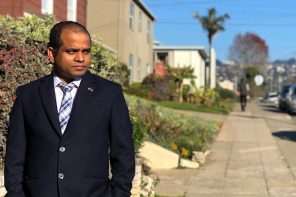The images of LGBTQ rights advocates celebrating in India—embracing one another, holding rainbow banners, and showered in confetti—appeared on September 6th throughout the global media. After almost a decade of legal battles, the Indian Supreme Court finally decriminalized LGBTQ sex when it decided that the colonial-era law known as Section 377, which bans sex “against the order of nature” and was enacted by the British in 1860, could not be used to discriminate against LGBTQ people. The Court ruled that such discrimination was “irrational, indefensible and manifestly arbitrary.” In the ruling, India shook the callous vestige of its colonial past.
The images took me back to 2009 when the Delhi High Court ruled to decriminalize LGBTQ sex, a ruling that the Supreme Court would overturn in 2013. I happened to be in India that day and remember the elated celebrants contrasted with the force of the pushback exploding into the public domain, resulting in an almost decade-long legal battle.
The Delhi High Court’s decision was groundbreaking not only in its recognition of LGBTQ rights, but also in the resistance it engendered from religious activists, especially right-wing Hindus who deployed a homophobic rhetoric of mental disease, family protection, and “Vedic culture,” a reference to what some consider traditional Indian culture as determined by orthodox interpretations of a carefully constructed Hindu canon.
High profile religious figures—Hindu, Christian, and Muslim—vocally condemned the decision. The Daily News and Analysis commented, “What emerged is the univocal unity of religious leaders in expressing their homophobic attitude. Usually divisive and almost always seen tearing down each other’s religious beliefs, leaders across sections came forward in decrying homosexuality and expressing their solidarity with the judgment.” Several public religious and political figures issued statements, ranging from deceitful to abusive, in favor of the criminalization of LGBTQ people, which they deemed “against the order of nature.”
Right-wing responses delimited publicly-sanctioned and state-protected sexuality to heteronormativity and modeled a right-wing strategy for opposing the civil rights of sexual minorities. “Deviant,” “diseased,” and other descriptors of sexual minorities were code words for homophobia and transphobia. Moving the discussion of Section 377 away from systemic inequality and toward the putative best interest of Indian society was emblematic of the right-wing attempt to erase sexual diversity.
Although right-wing Prime Minister Narendra Modi has remained silent on Section 377 since his election campaign in 2014 (during hearings in July 2018, the central government announced that it was not going to take a position on Section 377), the silence spoke volumes and went hand-in-hand with a Hindu chauvinist and exclusionary social agenda consistent with Modi’s training and membership in the Bharatiya Janata Party (B.J.P.).
Though attention to the exclusionary nature of Modi’s social agenda tends to focus on his complicity in Hindu-Muslim conflict, it doesn’t end there. His complicity in the ongoing criminalization of LGBTQ people allowed the B.J.P. and other conservative organizations to propagate a story of how the majority is imperiled by LGBTQ communities.
Although Modi refused to take an official stance on Section 377, he let his associates speak for him. These have included Home Minister Rajnath Singh, who said the B.J.P. would not support such “unnatural” acts, and member of parliament Subramanian Swamy, who, in 2015 said “our party position has been that homosexuality is a genetic disorder.” Most significantly, since his 2014 election, Modi and other parliamentarian members of his party have had the legislative power to initiate concrete action to decriminalize LGBTQ sex, yet they have not used it to do so.
Baba Ramdev—a yoga guru; Hindu renunciate; celebrity; entrepreneur; right-wing activist; the person who would become Modi’s most high-profile spiritual advisor; and Indian television’s poster boy for homophobia—publicly criticized the High Court’s 2009 decision and filed a petition in India’s Supreme Court demanding homosexuality’s recriminalization.
Stating that the High Court inappropriately intended to change moral norms, he suggested that the right to privacy should not include the right to deviant sexual behavior and that yoga could cure the disease of homosexuality. He described homosexuals as anti-social and said legalization would negatively affect India’s youth, damage the institution of marriage, and increase the prevalence of HIV/AIDS. Ramdev used his celebrity and moral authority to make a compelling threat that there would be nationwide protests if the Supreme Court did not strike down the High Court’s decision.
Representatives of other Indian religions also protested. For example, Maulana Abdul Khaliq Madrasi, a vice chancellor of Dar ul-Uloom, the main university for Islamic education in India, lamented the 2009 decision, stating it would “corrupt Indian boys and girls”; and Joseph Dias, General Secretary of the Catholic Secular Forum (CSF), warned Indian Christians were in danger of being lured by the “glamour of the gay world.”
Those voices wielded enormous power which culminated in the Supreme Court’s 2013 decision to restore the criminalization of LGBTQ sex, arguing that Parliament, not the courts, should take up the issue. In its judgment, the Court justified the ruling by writing that only a “minuscule fraction of the country’s population constitute lesbians, gays, bisexuals or transgenders.”
Ramdev celebrated the decision with a press conference, reiterating that homosexuality was a disease and invited homosexuals to his yoga ashram where they would find a cure. Another Hindu renunciate and politician, Yogi Adityanath, then a member of parliament representing the BJP and now the chief minister of Uttar Pradesh, said, “Homosexuality is dangerous to social morality. If social norms and boundaries are done away with, then there is not much difference between man and animal.”
Two years later, the idea that yoga cures homosexuality would appear in the rhetoric of another of Modi’s associates and advisors. In a 2015 interview, H.R. Nagendra—a prominent yoga researcher and teacher; nephew of H.V. Sheshadri, the former general secretary of the nationalist paramilitary R.S.S.; Modi’s long-term spiritual advisor; and chairman of the committee for the International Day of Yoga—spoke about yoga’s power to make homosexuality disappear.
Yet, despite all of the bluster and campaigning, when the same Supreme Court agreed this year to reconsider Section 377 in response to a petition claiming it violated LGBTQ Indians’ rights to equality and liberty, most of the religious voices that had advocated for retaining it fell silent. Although some of India’s Christian organizations appeared in court in defense of the law, arguing that sexual orientation was not innate and that decriminalizing LGBTQ sex would lead to the transmission of H.I.V., the large, mainstream religious organizations and figureheads, including Adityanath and Ramdev, did not participate in the debate.
And when the Supreme Court unanimously voted to extend all constitutional protections under Indian law to LGBTQ Indians and that any discrimination based on sexuality would be illegal, those voices remained largely silent. There were a few exceptions like Swami Chakrapani, for example, president of the right-wing organization All India Hindu Mahasabha, who said, “It’s shameful. We are giving credibility and legitimacy to mentally sick people.”
Did religious voices largely drop out of the debate because they knew it was a lost cause? The Supreme Court’s decision to end the use of Section 377 to discriminate, harass, and threaten LGBTQ Indians after nearly 160 years is no doubt worthy of attention. Modi’s silence and that of his religious allies, therefore, could be interpreted as progress when contrasted with the vocal homophobic and transphobic pushback that the initial 2009 decriminalization decision engendered.
Yet I fear the silence actually signals a calculated decision in favor of continued discrimination and oppression. Right-wing opponents likely knew that pushback on the categorization of LGBTQ sex as “unnatural” would fail, and anticipated that their silence would be interpreted as a gesture toward equity.
They remain unmoored, however, from social ideals like religious, gender, and sexual equality, and economic justice. The kind of neoliberal capitalism Modi represents relies on the very differences it sows—it reequires racial, sexual, gender, religious, and ethnic conflict to fuel competition and create new markets, and a division of labor in order to maximize the output from the working classes.
Under Modi’s neoliberalism, individuals are construed as automatons, ideally self-optimizing and entrepreneurial. Economic success is measured in terms of the growing GDP, even though the fruits of economic growth are not reaching all social strata. India’s human development index ranking, which measures life expectancy, education, and per capital income as calculated by the United Nations Development Program (UNDP), has dropped while Modi has been in power.
According to a 2017 report by ratings firm Crisil, “Persistent inequality reflected in the low human development attainments of the most marginalised groups, including scheduled castes, tribal and rural populations, women, transgenders, people living with HIV, and migrants, have brought down India’s HDI score.” A 2018 Crisil study reported, “Inequality is set to rise as the return on capital will increase compared with the return on labor. This will continue to concentrate wealth in a few hands, can be socially disruptive and pose a major policy challenge for a country like India, which already has high inequality and is set to add millions to the workforce in the coming years.”
Under Modi’s neoliberal rule, citizens are incessantly incited to accept full responsibility for their own well-being and self-care. This worldview is an unabashedly exclusionary one, encompassing only the Hindu, heteronormative capitalist classes—the so-called aspirational adherents—effectively erasing the vast majority of India’s population from view.
Thus we can only hope that the Supreme Court’s decision inspires the Modi government to rethink this ideology, which might result in actions to achieve social equality, such as establishing anti-discrimination laws as well as confronting other areas of sexual inequality, including India’s horrifying, yet thriving, sex slave industry.




